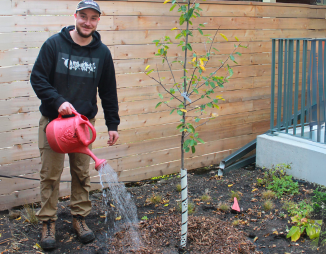
May 29, 2024
Justin Lewis
In our previous blogs, we explored tree and shrub species that support bees in early and mid spring. As spring turns to summer, native trees and shrubs continue to provide food for our native bees.
In this blog, we will explore four of the best late-spring blooming native trees and shrubs. Keep reading to find out why bees love trees!

May 15, 2024
Justin Lewis
Tags: Backyard Biodiversity
In our previous blog, we explored four tree and shrub species that support bees in early spring. As spring advances and pollinator gardens burst into bloom, it's important not to overlook the ongoing significance of native trees and shrubs in the bee lifecycle. In this blog, we will explore four of the finest mid-spring blooming native trees and shrubs. Keep reading to find out why bees love trees!

April 29, 2024
Justin Lewis
When considering the essentials for supporting bees, our minds often turn to vibrant pollinator gardens. However, it might surprise you to learn that bees depend on native trees as well. While trees help humans by offering shade, privacy, and aesthetic appeal, trees also play a crucial role in providing much-needed spring food and shelter for these vital pollinators.

March 29, 2024
Jess Wilkin
Tags: Tree Care
Sprinklers are a familiar sight on lawns and in gardens, but did you know that they have the potential to negatively impact trees by causing stress? Discover how watering with sprinklers can impact your tree and learn the key to properly watering in our newest blog.

March 20, 2024
Jess Wilkin
Oak trees fulfill significant ecological and cultural roles in our urban forest but in 2023, our mighty oaks came face-to-face with a new threat: oak wilt. Check out our top questions and answers about oak wilt and learn what you can do to help prevent the spread of this invasive pest.

March 20, 2024
Joel S.
Tags: Backyard Biodiversity
Enter a world of vibrant wings gracefully dancing amid the blossoms, turning your garden into a whimsical paradise where butterflies paint the air with their enchanting colours. If this imagery speaks to you, LEAF is here to help with your garden metamorphosis! Read on to find out more about our four favourite native shrubs that beckon to butterflies and discover the delights they can add to your yard!

March 06, 2024
Justin Lewis
Tags: Backyard Biodiversity
Do you dream of transforming your backyard into a biodiverse paradise where wildlife flourishes? If you have native trees and shrubs, or are considering planting some, you can enhance their ability to offer habitat by creating soft landings—diverse native plantings beneath the native trees. Read on to discover how soft landings can beautify your space while supporting a vibrant ecosystem right in your own backyard!

February 28, 2024
Amba P
Ever wanted to add a rare native tree to your yard that combines aesthetic charm and food production? Dive into the captivating culinary delight and cultural significance of native pawpaw trees! With their tropical-looking leaves and distinctive fruit, this member of the custard apple family (Annonaceae) is a true hidden gem. While pawpaws have a rich history of cultivation by First Nations communities, they’re gaining popularity among local farmers and home gardeners too, and for good reason! Read on to learn all about this delicious culinary gem that will delight your taste buds and leave you craving more.

February 21, 2024
Jon Curtis
Have you heard? If you reside in one of Toronto’s Neighbourhood Improvement Areas (NIAs), you might be eligible to have trees and shrubs planted on your property for FREE! LEAF is here to help make tree planting easier than ever this spring. Read on to learn more about what this exciting new initiative offers and how you and your community can take advantage of it!

February 21, 2024
Natasha Jovanovic
Hello – my name is Natasha, and since completing the Young Urban Forest Leaders (YUFL) program at LEAF last year, I’ve become the Education Coordinator. In this capacity, I’m responsible for organizing this free, hands-on training and mentorship program for Toronto youth. I’m excited to share how the program helped me find a fruitful career path in the environmental sector and how it inspired me to lead the 2024 cohort.
